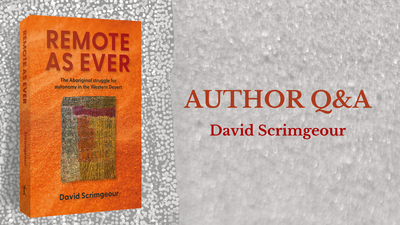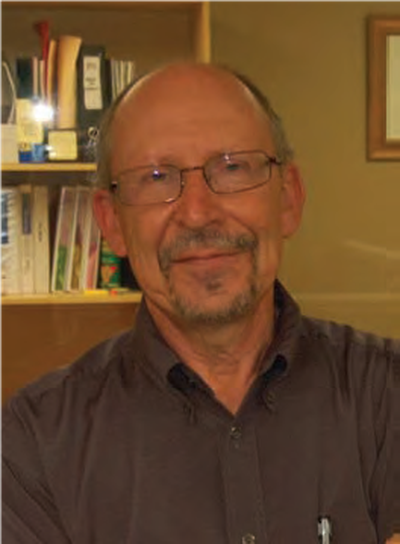Q & A with David Scrimgeour—Author of Remote as Ever

1. What is it like to work in a remote, Aboriginal community?
I should stress that my book is not meant to be about what it was like for me to work in remote communities, but rather about the people who established these communities, and their aspirations, written from the perspective of someone who was there.
However, clearly, I enjoy working in remote Aboriginal communities. The spectacular beauty of the Central Australian desert has always had a special appeal for me. There is the satisfaction which comes from working as a doctor alongside Aboriginal people in communities with a high level of health care need, within a structure which contributes to self-determination and where I am accountable to the community. I have lived and worked with some wonderful people in remote communities, some of whom are described in my book. I have found that I enjoy working within an Aboriginal environment. I particularly enjoy the pervasive sense of humour which is characteristic of Aboriginal communities (not just in remote communities—this is true in urban communities as well).
2. What difficulties did you face working in a remote community as a doctor?
While there are challenges, I think many of the difficulties are often overstated.
In a remote community one does not have access to the attractions of urban living, nor to the wider circle of family and friends. However, there are attractions of the bush which compensate. There are usually possibilities to meet some great people and nowadays there are ways one can maintain contact with one’s wider circle. I guess in my case, I have always been quite happy with my own company, especially if I have a supply of good books.
For a doctor in these settings, there is the concern that one is on one’s own, without professional colleagues down the corridor. However, even in my early days out bush, when communication was by two-way radio, there was always specialist advice and medical evacuation services available to assist when required. This is even more so nowadays with well-developed consultation services available over the telephone or by telehealth. Also, most Remote Area Nurses are very competent and able to manage difficult medical situations.
Occasionally, incidents occur in remote communities which receive media attention and sometimes lead to an impression that all non-local workers in remote communities are in an unsafe environment. While I acknowledge that such incidents can occur, this should not lead to assumptions that all Aboriginal people living in remote communities are at threat. Systems should always be in place to ensure that workers are safe, but this applies to all settings and is not specific to remote communities.
Overall, I think the attractions of working in remote communities significantly outweigh the difficulties.
3. Tell us a little about the ‘homelands movement’ and your involvement in it?
The homelands movement involved people leaving large missions and settlements to re-occupy their homelands, a movement was gathering pace when I first found myself working in remote Australia. In the Western Desert, where I worked, the homelands movement differed somewhat from the movement in other parts of Australia. During the assimilation era, people from the sparsely-populated desert regions found themselves in large settlements on the edges of settled Australia, far from their homelands, so the reoccupation of their country was more of an exodus, establishing new communities which were not just outstations around a larger settlement. Often there was an intention to disperse into many small communities, but I describe in my book how the dynamics of the movement led to communities equilibrating to a size of around 150 people, which is the average size of Western Desert Aboriginal communities today.
Large areas of the Western Desert had remained remote from settled Australia and when the desert people re-occupied their country, they re-established contact with families which had never left their homelands. I describe in my book the events around the last two families to be contacted and my involvement with these events. These differed from previous contact narratives in that in these cases, it was a re-establishing of contact among relatives, which consequently led to a better outcome.
4. Are there any government policies hindering Aboriginal health in remote communities?
I believe there are government policies which have an adverse effect on Aboriginal health, but more generally I think it has been the assumptions underlying government policy making and implementation that has been the problem. These assumptions are based on a deficit discourse, which views Aboriginal individuals, families, communities and organisations as at least potentially dysfunctional, and incapable of making appropriate decisions for themselves. These assumptions have been evident particularly for the past 20-25 years, initially with the Howard government but also with subsequent governments of either main party. This has led to wasteful funding directed to non-Aboriginal bodies rather than to Aboriginal organisations which have the necessary community knowledge and experience. In particular, the unwillingness of government to cede control to Aboriginal organisations has led to decreased opportunities for Aboriginal community-controlled health services to realise their true potential.
There have been some policies which have led to increasing marginalisation of people living in remote Aboriginal communities. In particular, the employment program called CDP has more onerous requirement than any other welfare-to-work program in Australia and has led to increasing pauperisation with adverse health consequences. Fortunately, after years of protests and a successful legal challenge, it is now in the process of being reformed.
On the other hand, there are some government policies which have the potential to improve health. Land management programs in remote communities, for example, have many positive benefits and should be developed further.
5. What message do you wish to leave readers with by the end of the book?
Through serendipity, in my early career I found myself involved with two Aboriginal social movements: the homelands movement and the Aboriginal community-controlled health service movement. I believe the histories of both these movements are significant and should be better understood.
Both movements reflected a desire for greater autonomy. They were examples of colonised people wanting to have more control over their own lives. Having control of the events affecting one’s life is an important determinant of health, so I believe these movements have the potential to improve health.
Government policies have not always reflected sufficient respect for this desire for autonomy, and thus have sometimes had an adverse impact on health. This appears to have been particularly true since the turn of the current century when there was a shift away from bipartisan support for self-determination to more neoliberal policies.
One hopes that a new respect for Aboriginal autonomy may be possible.



